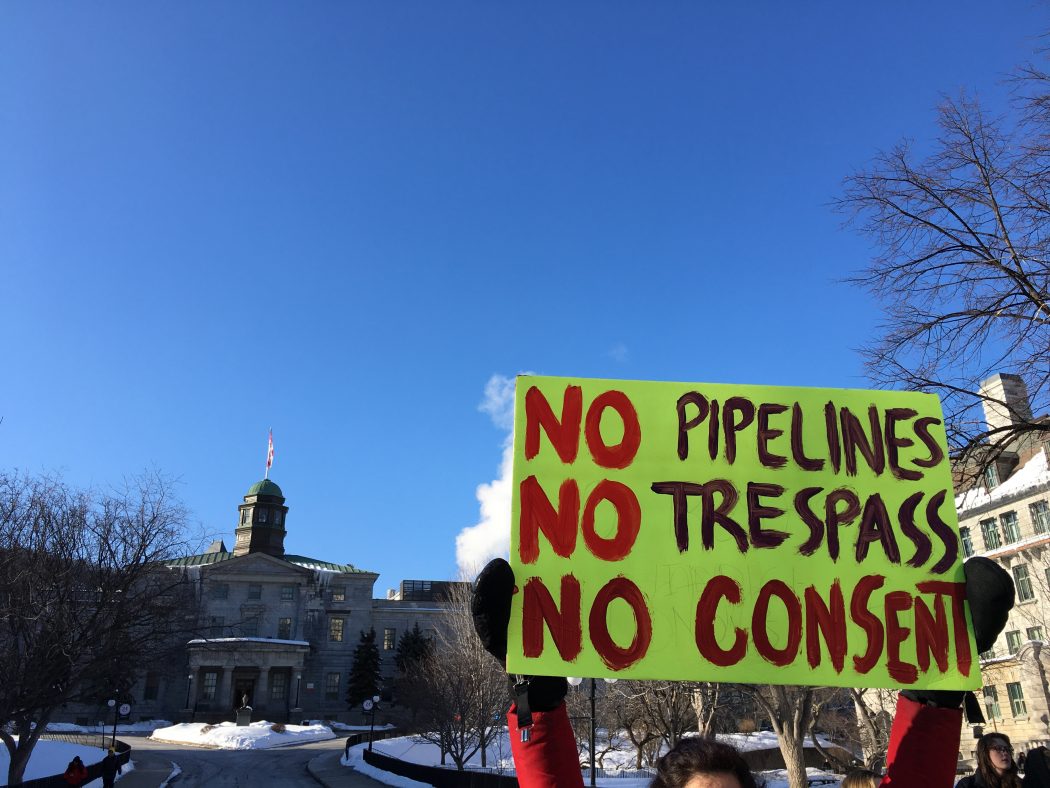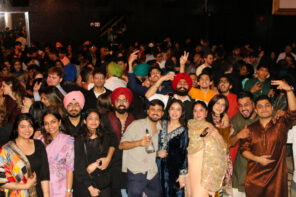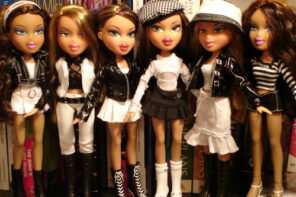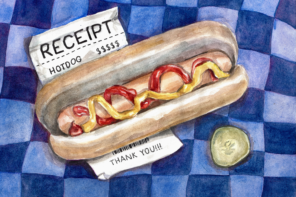Last Monday, in between lectures and McLennan meetings, I Metroed up to Villeray to witness a Wet’suwet’en solidarity demonstration. On a slushy day with snow piled high, crowds of protestors coalesced outside Prime Minister Justin Trudeau’s constituency building. Members of the Montreal community gathered to protest federal encroachment onto Wet’suwet’en territory amidst construction of the Coastal GasLink Pipeline. Standing across the street, I saw the sun bask cardboard signs and chattering, impassioned youth in a warm, orange hue.
On Monday, I wanted to cross the busy avenue and join in. Unfortunately, I had arrived too late, and the flame of the demonstration had already died out. The sun was setting. Activists were trudging home through the slush. It was time to gather our signs and duck back into the Metro.
I am frustrated that I couldn’t make myself cross that avenue last week. But this article isn’t — and shouldn’t — be about me or my activism efforts. It’s about the students who carved out the time, skipped class, and marched through the slush when the sun was still high to show solidarity with the Wet’suwet’en. They organize demonstrations through Facebook group chats and sell doughy bannock in Leacock. Many withstand tokenization in Poli-Sci conferences and underrepresentation in campus dialogue. And, as Wet’suwet’en activism in B.C. erupts into nationwide protests, Indigenous students on campus are speaking out louder than ever.
I sat down with U1 Arts student Catie Galbraith, member of the Chickasaw nation, and U0 Arts student Manon Gentes, member of the Saulteaux Métis, to talk about their experiences with Wet’suwet’en solidarity movements, Indigenous Student Alliance (ISA), and navigating McGill campus as Indigenous students.
ll these people that showed up…it felt really good to do something.
“It’s been a really quite crazy time,” shared Galbraith, regarding the recent string of demonstrations in Montreal. “A close friend of mine was recently arrested, so in my mind this is a very difficult time, but also a very exciting time. It’s amazing seeing all these Indigenous folks organizing.”
Gentes shared Galbraith’s enthusiasm about Indigenous solidarity. “Before it happened I felt kinda discouraged. I was outside my home, outside my community, and you can’t do anything from far away. But seeing these guys, their events. All these people that showed up…it felt really good to do something.”
The protest outside the constituency office was just the latest episode in a long-running series of solidarity acts for the Wet’suwet’en in Montreal. On February 11th, a previous sit-in occurred at the constituency office that led to police intervention. A month earlier, protests occurred at the Y-Intersection when the Wet’suwet’en hereditary chiefs initially spoke out against the Pipeline expansion.
Call Mark Miller, call Trans-Canada, share on social media, raise awareness, so people who aren’t currently paying attention will pay attention.
For those who can’t skip class and attend a demonstration in-person, there are several other ways to get involved show support for the Wet’suwet’en. “If you go to the Unist’ot’en website, they do have an option to let you donate to their legal website,” Galbraith informed. “Call your representatives. Call [Premier of British Columbia] John Horgan… Call your own representatives. Call Mark Miller, call Trans-Canada, share on social media, raise awareness, so people who aren’t currently paying attention will pay attention.”
Beyond action, Gentes added, it’s important to recognize the historical context behind these present-day protests. “Do your research in Canada’s history and what led up to this moment. It’s not straightforward. What’s happening now is the result of so many different actions.” She pauses. “In a general sense, I suggest you listen to Indigenous voices.”
Galbraith echoed a similar sentiment. “At the end of the day, no one can tell your story for you,” “That’s a basic tenet of activism. You can’t comprehend the lived experience of someone else. It’s important to recognize those lived experiences as valid even if you don’t agree with them. Recognizing that is always important.”
Oftentimes, Indigenous women assume leadership positions in these demonstrations. Last Monday’s protest in Villeray was organized by Galbraith and two other women, and the ISA’s executive board is a majority women team. Galbraith discussed the nature of this gendered leadership.
“[The ISA] is a really beautiful space that’s led by women and we take a lot of things into account: like the intersection between pipelines and the missing and murdered Indigenous women, and raising a different kind of awareness. At least in my own culture, there is a very strong relationship between women and water. It’s viewed as women are water.”
Galbraith went on to emphasize how Indigenous students only compose a small portion of our campus’ demographics. “We are 0.1% of the student body, there’s about 30-50 of us at any given time [at McGill].”
Indigenous students may be a minority on campus, but they are certainly not a monolith. Gentes stems from British Columbia, Galbraith from Indiana. Indigenous students hail from all over the continent, ranging from the Arctic to Eastern Canada. Despite these diverse backgrounds, there are some overarching experiences faced by most Indigenous students at McGill, which is where organizations like the ISA become so crucial.
Indigenous students on campus today are likely to experience numerous microaggressions. “In a class or a conference, if someone says a horrible thing, it’s so nice to be able to go to FPH (First People’s House) and be like, this terrible thing happened in my class today. And people can be like, I know, it’s hard, here’s how you deal with this. Here’s how I dealt with this when it happened to me.”
Gentes also commended First People’s House (FPH): a group whose mission is to provide First Nations, Métis and Inuit students with the necessary resources and support to make McGill feel hospitable. “There’s so many different people who go to FPH, so many different resources you can find here. It’s so easy here to feel alone, FPH people especially are super willing to help.”
Don’t overextend yourself. Don’t feel pressure to be the Native representative.
Despite the wealth of resources providing supporting Indigenous students on campus, university life can still be stressful. Indigenous students’ position as minorities sometimes makes them feel pressured to speak on behalf of their communities.
While activism is important, Galbraith warned incoming Indigenous students about the danger of spreading yourself too thin with commitments on campus. “Don’t overextend yourself. Don’t feel pressure to be the Native representative. People are going to ask you for a lot of labour just on the basis of your ethnicity. Give yourself space and time. Focus on your own needs first.”
*
Between midterms and demonstrations, Galbraith and Gentes took the time to speak to The Bull & Bear about Indigenous student life on campus. Our interview felt like casual conversation, but I know that for these students this was just one pit-stop in a busy day of hard work and balancing acts. The sun may have already set on that slushy, Villeray protest, but for students like Galbraith and Gentes, the work is ongoing.
As for the rest of us at McGill? Hopefully we can learn to muster up the courage to cross that busy avenue and join in too, but not before listening to the voices that should truly be capturing our attention.
Resources:








